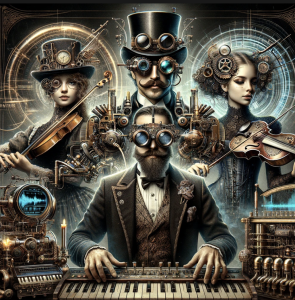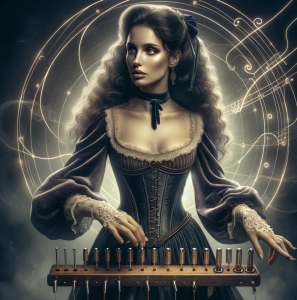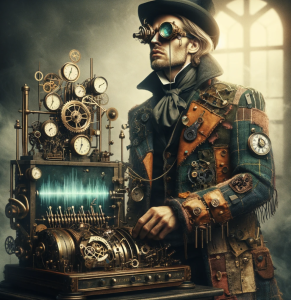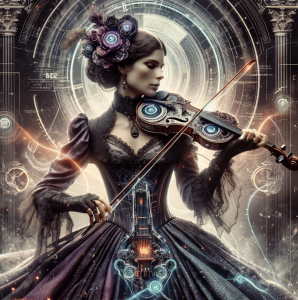Author: vpreciado24
Visual Assignment #2
Link To the Google Slides: https://docs.google.com/presentation/d/12jHYV0rREDx69Z-gcXEGyFBZPAaa_dfJsj8T0ul6CTA/edit?usp=sharing
Blog #6
Can’t be an Illusion tells the story of Althea, a young woman living in the surreal world of Vitak, where reality is questioned, and the mundane is redefined. Encountering anomalies in her world, Althea is drawn into a journey of discovery, guided by her best friend Kai, a vibrant anomaly urging her to question her reality. Through the alarming and unnatural encounters Althea confronts the dual nature of her world, choosing to embrace the chaotic beauty of truth over the comfort of illusion. Her journey from acceptance to enlightenment reflects a deeper exploration of perception, consciousness, and the power of the human spirit to shape reality, ultimately transforming Althea into a beacon of insight for others navigating the complexities of their own perceptions.
Using a mystical and reflective tone with a blend of vibrant, fluid visuals and ethereal soundscapes in order to immerse viewers in the enigmatic world of Vitak. The visual style should richly depict the surreal landscapes and symbolic imagery like the Fractured Clock, contrasting the illusory beauty of Vitak with the sharper realities Althea discovers. Sound design should feature emotive instrumentals and distinctive motifs for characters, enhancing the narrative’s philosophical depth. The music will be mystical, with synths. Through detailed storyboarding and thoughtful character design to ensure that the film visually and audibly represents the journey from illusion to enlightenment, engaging the audience in a profound sensory and contemplative experience.
Blog #5
Blog #5
AI Cinema represents a paradigm shift in the landscape of filmmaking, echoing the transformative impacts of historical milestones like the agricultural, industrial, and internet revolutions (https://www.theguardian.com/film/2023/mar/23/ai-change-hollywood-film-industry-concern). At its core, AI has the potential to revolutionize the way stories are told, visualized, and shared, offering both unprecedented opportunities and significant risks to the industry.
Opportunities for Hollywood and Independent Artists
For Hollywood, AI cinema could unlock new realms of creativity and efficiency. By automating certain aspects of production, such as visual effects creation, scene composition, and even script writing assistance, AI can significantly reduce the time and financial investments required to bring stories to life. This democratization of filmmaking tools could level the playing field, allowing independent artists to compete with major studios by creating high-quality content with lower budgets. Furthermore, AI’s ability to analyze vast amounts of data could lead to more targeted and engaging content, potentially increasing the success rate of productions by predicting audience preferences more accurately.
For independent artists, AI offers a toolset that was previously inaccessible due to cost or technical skill barriers. AI can serve as a collaborative partner, offering suggestions for narrative development, visual aesthetics, or even music composition, thus enhancing the creative process. This could lead to a surge in innovative content, as artists are empowered to experiment and express their visions in ways that were previously unimaginable.
Risks and Considerations
However, the integration of AI into cinema is not without its challenges and risks. One of the primary concerns is the potential for job displacement. As AI takes on more roles traditionally filled by humans, from scriptwriting to post-production, there’s an understandable fear that it could reduce the number of opportunities available to professionals in the field. Moreover, the reliance on AI in creative processes might lead to questions about the authenticity and originality of art. When a machine contributes significantly to a piece of content, it raises philosophical debates about the nature of creativity and authorship.
Another significant risk involves ethical considerations and biases inherent in AI systems. AI learns from existing data, and if that data reflects historical biases or stereotypes, AI-generated content could perpetuate these issues rather than contribute to a more diverse and inclusive media landscape.
The Future of AI Cinema
Looking forward, the integration of AI into Hollywood and independent cinema is likely to follow a path of cautious optimism. Regulation and ethical guidelines will play crucial roles in mitigating risks, ensuring that AI is used responsibly and beneficially. Moreover, education and re-skilling initiatives will be essential to help industry professionals adapt to the changing landscape, ensuring they can leverage AI tools to enhance their craft rather than be replaced by them.
In conclusion, AI cinema stands at the cusp of revolutionizing the entertainment industry, offering tools that can amplify human creativity and redefine the economics of filmmaking. By embracing these tools while thoughtfully addressing their risks, the future of Hollywood and independent cinema could be one of unparalleled innovation and inclusivity.
Gothic Groove Machine
“Echoes Through the Aether”
This conceptualization creates a rich, immersive world that combines the elegance and inventiveness of the Victorian era with the boundless possibilities of techno music. The band and its music tell a story of innovation, creativity, and the timeless appeal of blending different eras and genres.






Blog Post #4
The process begins with an initial brainstorming phase to establish the foundational elements of the fictional world. Themes, settings, characters, and plotlines are carefully considered, and free writing exercises are used to foster creativity and explore various ideas. As someone deeply intrigued by the relationship between people and reality, I found myself drawn to the concept of a world where the lines are blurry, where perception is fluid, and truth is subjective. I focused on using my AI tools to generate alternative scenarios and snippets of text, providing additional inspiration and enriching the depth of the world-building process.
Once the initial concept is formulated, the development phase commences. This stage focuses on fleshing out the intricate details that breathe life into the fictional world. Elements such as culture, history, geography, and technology are meticulously crafted to create a cohesive and immersive experience. I often found myself grappling with the notion of reality within the context of my fictional world, exploring how perceptions shape relationships and interactions between characters. The idea that a world that was once like ours intrigued me/
I noticed that the integration of AI tools into the creative process significantly enhances efficiency and productivity. By leveraging AI-generated content, such as landscapes, character designs, and textual descriptions, creators can bring their worlds to life with greater ease and fidelity. The use of AI suggestions serves as a catalyst for creativity, providing a wealth of ideas and possibilities that may not have been considered otherwise. Asking AI to generate ideas also helps sway the story and creates more depth.
Furthermore, AI tools enable creators to explore a wider range of themes and ideas within their fictional worlds. Themes such as power dynamics, identity, morality, societal evolution, and environmentalism can be more effectively integrated into the narrative, enriching the storytelling experience and stimulating thought-provoking discussions.
In conclusion, world-building with the assistance of AI tools offers a systematic and efficient approach to creative storytelling. By following a methodical process that encompasses brainstorming, development, and the integration of AI-generated content, creators can craft immersive and engaging fictional worlds that resonate with audiences. The use of AI suggestions facilitates rapid iteration and refinement, allowing for greater exploration and creativity.
Vitak – Fictional World
In the shimmering realm of Vitak, where the sky blazed with hues of crimson and gold, a mysterious creature known as Nala drifted silently through the ethereal landscape. Unlike the inhabitants of this enchanted planet, Nala possessed a unique ability – the power to see beyond the veil of reality, to witness the souls that danced and intertwined within the fabric of existence.
Vitak was a world unlike any other, where the very essence of reality was shaped by the collective imaginations of its inhabitants. Each creature saw the world through their own lens, creating a tapestry of dreams and illusions that stretched across the horizon.
But beneath the surface of this idyllic paradise lay a dark truth – Vitak was once a world much like Earth, ravaged by the same greed and ignorance that had led to humanity’s downfall. The people of Vitak, having learned from the mistakes of their predecessors, had vowed to create a perfect world, free from the destruction and chaos that had befallen their sister planet.
Yet, even in this seemingly utopian paradise, there were whispers of discontent. As Nala drifted through the endless expanse of Vitak, she sensed a disturbance in the fabric of reality – a shadow lurking just beyond the edge of perception.
And then, one fateful day, it happened. As Nala gazed upon the horizon, she saw something that sent a shiver down her spine – the souls of Vitak, laid bare before her like threads of light, tangled and twisted in a chaotic dance.
It was as if a veil had been lifted, revealing the true nature of Vitak’s reality. The creatures around her remained oblivious, lost in their own illusions, but Nala could see them all – the joy, the pain, the fear, laid bare for all to see.
As she moved through the shimmering landscape, Nala realized the enormity of what she had discovered. Vitak was not the perfect world its inhabitants believed it to be – it was a fragile illusion, held together by the collective will of its people.
Determined to uncover the truth, Nala embarked on a journey to confront the leaders of Vitak, to reveal the dark secret that lay hidden beneath the surface of their idyllic paradise. But as she delved deeper into the mysteries of Vitak, she realized that the truth was far more complex than she could have ever imagined.
For Vitak was not just a world of dreams and illusions – it was a reflection of the souls that inhabited it, a testament to the power of imagination and the human spirit. And as Nala stood on the brink of revelation, she knew that the fate of Vitak hung in the balance, teetering on the edge between reality and illusion.
Writing Assignment #1
In the realm of independent filmmaking, the journey from concept to a finished film is a complex and daunting challenge as a creator. My project, titled “Leveraging AI to create Films,” seeks to explore and harness the transformative power of artificial intelligence (AI) in this creative endeavor. At the heart of this exploration lies a pivotal question: How can AI be effectively integrated into the filmmaking process to not only enhance creativity but also ensure cohesion in the production of short films?
The inspiration for this inquiry springs from a common dilemma faced by filmmakers like myself – transforming a burst of creative ideas into a harmonious and complete film. While individual elements like intriguing plot points or captivating shots may come naturally, weaving them into a cohesive narrative is often the most significant hurdle. Here, AI presents an intriguing solution. By using AI tools for various filmmaking aspects, including plot development, character design, background creation, music composition, and editing, this project aims to demonstrate a possible alternative approach to filmmaking that harmonizes these disparate elements.
Studies in AI’s application in creative fields have primarily focused on its role in generating individual elements like music or visual effects. However, there’s a noticeable void in understanding how AI can orchestrate these elements into a unified narrative and aesthetic experience. This project, therefore, not only taps into the potential of AI in enhancing individual aspects of filmmaking but also delves into its role as a unifying force, bridging gaps between isolated creative flashes.
The methodology of this project will be a hands-on exploration of AI tools across all stages of film production. This process, documented meticulously, will enable a thorough analysis of how each AI-generated component contributes to the film’s overall narrative and aesthetic quality. The culmination of this process will be a short film, embodying the seamless integration of AI in filmmaking. This film will not only serve as a testament to the quality achievable through this AI-assisted approach but also as a project available to the public to experience, showcasing the practical viability of AI in independent film production.
As the semester progresses, the project will evolve through distinct phases, starting with the initial month dedicated to concept development and selection of appropriate AI tools. The following two months will be the crucible of production, where ideas and AI-generated elements coalesce into tangible film sequences. The final month will see these sequences refined into a polished film, ready for audience and critical reception.
This endeavor, while an academic pursuit, transcends the classroom. It aims to contribute a new perspective to the independent filmmaking world, offering a blueprint for integrating AI into the creative process. By addressing and overcoming the challenge of narrative and aesthetic cohesion, this project seeks to inspire a new wave of filmmakers who harness the power of AI to bring their visions to life.
In conclusion, “Leveraging AI to create Films” is more than just a project; it is a journey into the uncharted territory of AI-assisted filmmaking. It represents a bridge between fragmented creative ideas and the realization of a cohesive, engaging short film. As the final product screens, it will not only mark the culmination of a semester’s work but also the beginning of a new chapter in the narrative of independent filmmaking, where AI is a collaborator, a unifier, and a catalyst for creative expression.